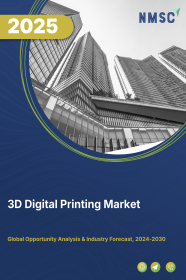
3D Digital Printing Market by Component (Hardware, Software, and Services), by Printer Type (Desktop 3D Printer and Industrial 3D Printer), by Technology (Stereolithography, Fuse Deposition Modelling, Selective Laser Sintering, Direct Metal Laser Sintering, Poly Jet/ MultiJet Printing, Inkjet Printing, Electron Beam Melting, Laser Metal Deposition, Digital Light Processing, Laminated Object Manufacturing, and Others), and Others - Global Opportunity Analysis and Industry Forecast, 2022 - 2030
3D Digital Printing Market Overview
The 3D Digital Printing Market size was valued at USD 13.60 billion in 2021 and is predicted to reach USD 42.56 billion by 2030 with a CAGR of 13.5% from 2022 to 2030. 3D digital printing or additive manufacturing is a process that is used to create three-dimensional solid objects from a digital file. A 3D printer creates an object by laying down successive layers of additive materials.
To create these precise geometric shapes, it uses collective data from computer-aided-design (CAD) software or 3D object scanners. 3D digital printing is gaining popularity across various industry verticals such as aerospace and defense industries, as it can create cost-effective prototypes with high efficiency and enables a manufacturer to produce complex shapes using less material than traditional printing methods.
Market Dynamics and Trends
The adoption of additive manufacturing technology is increasing rapidly in automotive sector across the world, as 3D printing helps to create high detailed & accurate scale models for designs & concept demonstration, for prototyping of physical parts such as interior elements of vehicles, and to create custom, complex, and high-performance parts.
For instance, in August 2019, Global car manufacturer Toyota Motor Corporation entered in partnership with 3D Systems. Under this partnership program, 3D systems will provide its 3D printers named Figure 4 Standalone, ProX 800, sPro 60, sPro 230, and Geomagic Design X software to incorporate into Toyota’s manufacturing workflow.
Also, rising demand for 3D digital printing in the aerospace industry is further driving the market growth, as 3D printing enables rapid prototyping, replacement, consolidation of multiple parts, and building tooling fixtures. For instance, in May 2021, NASA partnered with Aerojet Rocketdyne to advance 3D printing technologies and its capabilities for liquid rocket engines in landers and on-orbit spacecraft’s.
In addition, the rising application of 3D digital printing in healthcare sectors to create prostheses, implants, and generate accurate prototypes of medical devices are further fueling the growth 3D printing market. For instance, in November 2021, Johnson & Johnson (J&J) collaborated with the National University Hospital (NUH) to launch a 3D Printing Point of Care lab in Singapore. This initiative was supported by the Singapore Economic Development Board (EDB) to accelerate healthcare innovation in Singapore.
However, high maintenance of industrial 3D printers, and limited availability & high cost of materials used in 3D printing are the factors restraining the 3D digital printing market. On the contrary, introduction of 3D printers that can create prototypes of electronic components such as 3D Printed Circuit Boards (PCBs), antennae, capacitors, and sensors reducing the manufacturing cost is expected to create ample opportunities for the market in coming years.
Market Segmentations and Scope of the Study
The 3D digital printing market report is segmented on the basis of component, printer type, technology, process, application, material, end-user industry, and geography. Based on components, the market is divided into hardware, software, and services. On the basis of printer type, the market is classified into desktop 3D printer and industrial 3D printer. Based on technology, the market is categorized into stereolithography (SLA), fuse deposition modelling (FDM), selective laser sintering (SLS), direct metal laser sintering (DMLS), poly jet/ multi jet printing (MJP), inkjet printing, electron beam melting (EBM), laser metal deposition (LMD), digital light processing (DLP), laminated object manufacturing (LOM), and others.
On the basis of process, the market is classified into powder bed fusion, vat photopolymerization, material extrusion, material jetting, binder jetting, and other processes. Based on application, the market is categorized into prototyping, tooling, and functional part manufacturing. On the basis of material, the market is divided into polymer, metal, and ceramic. Based on end-user industry, the market is categorized into automotive, aerospace & defense, healthcare, architecture & construction, education, and others. Geographic breakdown and analysis of each of the aforesaid segments includes regions comprising North America, Europe, Asia Pacific, and Rest of the World.
Geographical Analysis
North America holds the lion share of 3D digital printing market share and is expected to continue its dominance during the forecast period. This is attributed to the factors such as high healthcare expenditure in this region that enables healthcare providers to adopt advance technologies such as 3D digital printing for patient-specific surgical models, affordable prostheses, and dental implants.
For instance, in November 2019, 3D Systems received clearance from the U.S. Food and Drug Administration (FDA) for its dental 3D printing material called Denture 3D+ and dental 3D printer NextDent 5100. Moreover, presence of key market players such as Protolabs, Xometry Inc., Stratasys Ltd., and Velo3D Inc. further boosts the market growth in this region.
For instance, in January 2022, Protolabs launched a post-processing technology called vapor smoothing for 3D printed production parts. Vapor smoothing can enhance the finishing of 3D printed parts including complex geometries.
On the other hand, Europe is expected to show a steady rise in the 3D digital printing market owing to the high adoption of 3D digital printing in the architecture and construction sector to create structures and concept models for fast construction and low material waste.
For instance, in November 2021, Peri group announced that it is building a 3D printed office space in Austria by using construction 3D printers of COBOD International. These construction 3D printers will significantly minimize the construction time of the building as they are capable of printing concrete, polymer, metal, or other materials, layer-by-layer.
Moreover, several initiatives taken by the government in this region further boost the adoption of 3D digital printing in this region. For instance, in July 2019, European Union contributed 30 million USD for the project called Target Argo. This investment will help Italian 3D printing firm Roboze S.P.A. in the development and upgradation of its research laboratories to expand its 3D printer’s portfolio, which will be used to create a range of industrial large-scale components in Europe.
Competitive Landscape
Various market players operating in the 3D digital printing market include 3D Systems, Xometry Inc., Stratasys Ltd., Protolabs, Velo3D Inc., Desktop Metal Inc., Materialise N.V., Nano Dimension, Markforged Holding Corp., and Shapeways Holdings Inc. These market players are adopting various strategies such as acquisition, product launches, and business expansion to maintain their dominance in the 3D digital printing industry.
For instance, in February 2022, 3D Systems entered into an agreement to acquire Kumovis GmbH. Through this acquisition, 3D Systems will be able to expand its polymer printing portfolio for healthcare using Kumovis extrusion technology.
Moreover, in May 2022, Stratasys Ltd. launched manufacturing materials across three different 3D printing technologies including third-party materials for Fused Deposition Modeling (FDM) 3D printers. It will help Stratasys to enhance its product portfolio with the addition of sixteen new materials, which will be used in wide variety of 3D printing settings.
Key Benefits
-
The 3D digital printing market report provides the quantitative analysis of the current market and estimations from 2022 to 2030. This analysis assists in identifying the prevailing market opportunities to capitalize on.
-
The study comprises of a detailed analysis of the 3D digital printing market trends including the current and future trends for depicting the prevalent investment pockets in the market.
-
The information related to key drivers, restraints, and opportunities and their impact on the 3D digital printing market is provided in the report.
-
The competitive analysis of the market players along with their market share in the 3D digital printing market is mentioned.
-
The SWOT analysis and Porter’s Five Forces model are elaborated in the study.
-
The value chain analysis in the market study provides a clear picture of the stakeholders’ roles.
3D Digital Printing Market Key Segments:
By Component
-
Hardware
-
Software
-
Services
By Printer Type
-
Desktop 3D Printer
-
Industrial 3D Printer
By Technology
-
Stereolithography (SLA)
-
Fuse Deposition Modelling (FDM)
-
Selective Laser Sintering (SLS)
-
Direct Metal Laser Sintering (DMLS)
-
Poly Jet/ MultiJet Printing (MJP)
-
Inkjet Printing
-
Electron Beam Melting (EBM)
-
Laser Metal Deposition (LMD)
-
Digital Light Processing (DLP)
-
Laminated Object Manufacturing (LOM)
-
Others
By Process
-
Powder Bed Fusion
-
VAT Photopolymerization
-
Material Extrusion
-
Material Jetting
-
Binder Jetting
-
Other Processes
By Application
-
Prototyping
-
Tooling
-
Functional Part Manufacturing
By Material
-
Polymer
-
Metal
-
Ceramic
By End-User Industry
-
Automotive
-
Aerospace & Defense
-
Healthcare
-
Architecture & Construction
-
Education
-
Others
By Geography
-
North America
-
U.S
-
Canada
-
Mexico
-
-
Europe
-
Germany
-
France
-
Italy
-
Spain
-
United Kingdom
-
Russia
-
Sweden
-
Rest of Europe
-
-
Asia-Pacific
-
Australia
-
China
-
India
-
Japan
-
South Korea
-
Indonesia
-
Singapore
-
Rest of Asia-Pacific
-
-
RoW
-
UAE
-
Brazil
-
South Africa
-
Israel
-
KSA (Kingdom of Saudi Arabia)
-
Turkey
-
Remaining Countries
-
Key Players
-
3D Systems
-
Xometry Inc.
-
Stratasys Ltd.
-
Protolabs
-
Velo3D Inc.
-
Desktop Metal Inc.
-
Materialise N.V.
-
Nano Dimension
-
Markforged Holding Corp.
-
Shapeways Holdings Inc.
REPORT SCOPE AND SEGMENTATION:
|
Parameters |
Details |
|
Analysis Period |
2021–2030 |
|
Base Year Considered |
2021 |
|
Forecast Period |
2022–2030 |
|
Market Size Estimation |
Billion (USD) |
|
Market Segmentation |
By Component (Hardware, Software, and Services), by Printer Type (Desktop 3D Printer and Industrial 3D Printer), by Technology (Stereolithography, Fuse Deposition Modelling, Selective Laser Sintering, Direct Metal Laser Sintering, Poly Jet/ MultiJet Printing, Inkjet Printing, Electron Beam Melting, Laser Metal Deposition, Digital Light Processing, Laminated Object Manufacturing, and Others), by Process (Powder Bed Fusion, VAT Photopolymerization, Material Extrusion, Material Jetting, Binder Jetting, and Other Processes), by Application (Prototyping, Tooling, and Functional Part Manufacturing), by Material (Polymer, Metal, and Ceramic), and by End-User Industry (Automotive, Aerospace & Defense, Healthcare, Architecture & Construction, Education, and Others) |
|
Geographical Segmentation |
North America (U.S., Canada, Mexico) Europe (Germany, France, Italy, Spain, United Kingdom, Russia, Sweden, Rest of Europe), Asia-Pacific (Australia, China, India, Japan, South Korea, Indonesia, Singapore, Rest of Asia-Pacific), Rest of the World (UAE, Brazil, South Africa, Israel, KSA (Kingdom of Saudi Arabia), Turkey, Remaining Countries) |
|
Companies Profiled |
3D Systems, Xometry Inc., Stratasys Ltd., Protolabs, Velo3D Inc., Desktop Metal Inc., Materialise N.V., Nano Dimension, Markforged Holding Corp., and Shapeways Holdings Inc. |




















 Speak to Our Analyst
Speak to Our Analyst
























